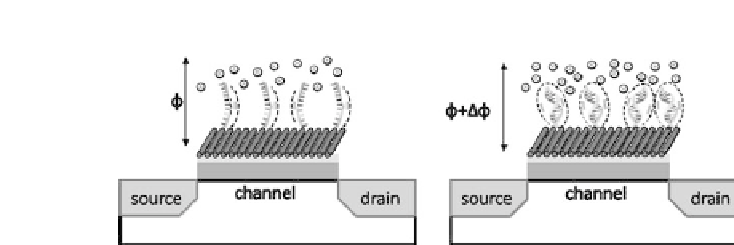Biology Reference
In-Depth Information
Figure 6.4.
DNA immobilization and hybridization on the gate metal of a
FET. See also ColorInsert.
moments occurring with bio-a
nity reactions. It can also be due
to potential changes arising from biochemical processes in living
systems, such as the action potential of nerve cells. The FET acts as
a potentiometric transducer.
In the case of DNA, the increase in negative charge in a
layer of immobilized DNA probes upon hybridization with target
oligonucleotides causes a significant change in
ϕ
0
(Fig. 6.4). If
immobilization is on the gate of an FET, hybridization causes a
shift in the flat-band potential,
V
fb
, of the semiconductor. This
causes a shift in the current-voltage (
I
-
V
) characteristic of the FET
[4,7,9].
Field-effect DNA biosensors have been fabricated with very
different approaches to immobilization strategies, hybridization,
rinsing,andmeasurementconditions.Thesehavehadvaryinglevels
of success, achieving different immobilization densities, hybridiza-
tion e
ciencies, amount of non-specific binding, and stability. For a
high sensitivity, a large voltage shift upon hybridization is needed.
This requires a large increase in surface charge density upon
hybridization, requiring a large surface density of probes that still
allowshighhybridizatione
ciency.Toachieveastable,high-density
probe layer resulting in high e
ciency hybridization, end-tethered
covalent attachment is necessary. Many designs are based upon
functionalization of the gate dielectric of an ISFET. However, since
the pH selectivity of the gate oxide is not required, functionalization
of a gate metal is an option that allows immobilization using
thiol chemistry. This enables easy and reproducible fabrication of
high-density and highly stable mixed self-assembled monolayers of








